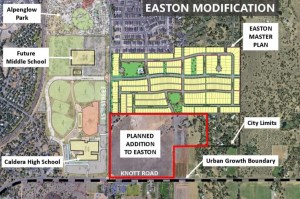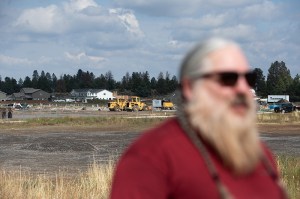Neighbors fear losing shops and services promised in Easton’s master plan, while city leaders say state law leaves them little choice
On a recent afternoon across the street from Bend’s newest school, Caldera High, trucks and excavators toiled in the dirt in front of rows of two-story homes — new additions to a development that will eventually include 720 housing units.
Across a freshly paved street, just within the border of Bend’s city limits, eight acres sat quiet.
The land was set aside for shops and businesses, from food stores to barbershops to medical clinics.
Despite that designation, half of the land could become affordable housing.
Last month, plans were submitted for a 128-unit income-restricted housing development that caught some neighbors off guard, leading to questions of whether thousands of new residents will have enough businesses close by to support their daily needs — and among city leaders about whether the city’s planning processes are working properly.
Commercially-zoned property in the 123-acre Easton development near Caldera High School in southeast Bend was the main topic of conversation during a Monday board meeting of the Old Farm Neighborhood District, which represents residents in the area.
Pahlisch Homes, a large regional builder based in Bend, is leading the development. Pahlisch has developed many of the newest neighborhoods in southeast Bend.
Representatives from Pahlisch did not respond to emails and phone calls requesting comment for this story.
For James Dorofi, chair of the Old Farm board, the new plans are not only a let down for neighbors who were expecting the amenities, but set a dangerous precedent for the future of Bend’s growth. He feels the extensive public planning process completed for the Easton community has been undermined.
James Dorofi stands with his dog, Nico, at the site of proposed commercial development across from Caldera High School in Bend on Thursday. (Joe Kline/The Bulletin)
And, he fears pinching commercial buildings out of Bend’s fastest-growing area that’s already short on neighborhood amenities will only lead to more congestion on roads and more pollution.
“We’re not against apartment complexes,” he said, “But if the commercial gets used for non-commercial purposes, then what do we have left?”
City’s hands are tied
The commercial land at Easton lies east of 15th Street and just north of Knott Road, at the very edge of the city limits and the urban growth boundary.
The city views Easton as the “gateway” to the nearly 500-acre southeast expansion area, nicknamed the city’s “elbow,” that was added to the city’s growth boundary in 2016. City planners designated 67 acres of commercial plans, 76 acres of industrial designations and 103 gross acres of mixed employment plan designations.
Those quantities of land were set by city planners during the 2016 urban growth boundary expansion, based on how much of each type of land they thought the city would need to support growth over 20 years. The expansion added 2,380 acres to the city.

A map from 2020 shows the location of the Easton Master Plan and land that was added to the development, which included 10 acres of commercially-zoned property at the southern end. (Old Farm Neighborhood District)
When developers submit master plans for large neighborhoods, they are allowed to rearrange the layout of different uses, but the zoning proportions must stay roughly the same. That is the planning mechanism behind the city’s policy to create “complete” communities: “Varied housing options, services, and amenities needed for daily living, including public schools, parks and open spaces, shops, and services, all within a convenient walking or biking distance.”
The Easton Master Plan was approved in 2023.
But in 2023, looking to knock down barriers for affordable housing construction, the Oregon legislature passed a law allowing it across all zones, including commercial. At the new affordable housing proposed for Easton, all 128 units will be restricted for people making 60% of the area median income or less, or $48,000 for an individual.
The development is led by Montana-based affordable housing developer United Housing Partners, in partnership with the Latino Community Association.
The city’s hands are tied when it comes to affordable housing with a certain number of income-restricted units.
“We didn’t have a crystal ball to tell us the state was going to allow residential (in the commercial zone),” said Colin Stephens, the city’s community development director. “We just had to accommodate what the state has told us to accommodate.”
Concern over trends continuing
Three months ago, Mike Ritchey moved from Eugene to the Bridges subdivision in southeast Bend, a 380-home Pahlisch development across from Alpenglow Park. He rode his bike past Easton’s vacant commercial land on a recent afternoon.
Ease of travel, along with proximity to the 37-acre park and Caldera High School, are some of the reasons Ritchey and his family moved across the mountains.
“We had heard this was going to be commercial down here,” Ritchey said. “That was of interest to us. I can’t say it was a major decision maker for us, but it was helping. We were excited that there would be something down here.”
Dorofi has kept a close eye on development in the area, and has seen commercial lands cut down elsewhere. He points to the 120-lot Luderman Crossing subdivision near Reed Market and 15th Street, another Pahlisch Development that didn’t include commercial space. A little ways to the north at 15th and Wilson Avenue, the 518-unit Wildflower development by Seattle-based Evergreen Housing Development Group reduced the size of its commercial land from initial plans, drawing criticism from land use groups.
One was Central Oregon LandWatch, a nonprofit advocate and litigator. Now, the group is concerned more developments are whittling away at the commercial parts of their master plans.
That’s playing out in northeast Bend at Pahlisch Homes’ Petrosa neighborhood, a 180-acre master plan in northeast Bend.
A deed restricted apartment complex was recently proposed for about one-quarter of the 20-acre commercial space at Petrosa. Like in southeast Bend, all of the units — 102 — will be restricted to people making less than $48,000 a year for individuals, or $68,000 for a family of four.
Bend needs nearly 10,000 units at or below that price point in the next 20 years to keep up with growth, according to a state analysis.
It’s led by the same developers of the affordable housing at Easton.
Owners have also discussed subdividing the rest of the commercial property into about 15 lots “for future commercial uses,” according to preliminary application materials submitted last month.
Still plenty of room for shops
The market for new business space can take years to ripen as homes are built. In recent years, interest rates and construction costs have made development more challenging.
But even with shaved-down commercial areas, there may still be plenty of space for shops to serve neighborhoods.
Russell Huntamer, who is brokering the commercial sale for Compass Commercial, expects that the affordable housing will only add to the appeal for potential businesses looking to set up shop on the remaining four acres. Huntamer said there is interest from a wide range of businesses, including a medical office, food hall, convenience store and national coffee brand.
He said eight acres was “probably more than necessary for commercial uses” in the Easton development. Four will be sufficient to provide a healthy mix of businesses, he said.
Dorofi is concerned the commercial cutback will make it impossible for a larger grocery store to locate there.

Construction is underway behind James Dorofi at the site of proposed commercial development across from Caldera High School in Bend on Thursday. (Joe Kline/The Bulletin)
Mayor calls for change in planning process
Bend Mayor Melanie Kebler, who lives in southeast Bend, said she sees why neighbors are upset, and called the concerns about the lack of commercial development there “very valid.”
The city needs income-restricted housing, she said, and the state laws allowing it are well-intentioned. So are the city’s planning efforts to create commercial areas.
But it may be too hard to predict how much commercial land the city will need in the future, she said.
“I think we need to move away from the master planning process, in which plans are made that may take a decade to come to fruition, and which are subject to market changes and developer business decisions that can confuse and frustrate the public,” she said.
The mayor and others on the council want a way to bring businesses to neighborhoods faster.
Some local policy groups have offered a solution.
Bend YIMBY, a pro-housing advocacy group, and nonprofit land-use litigator Central Oregon LandWatch, recently pitched to a city committee a set of code changes that would lift restrictions on small-scale businesses in residential zones. The code changes could allow people to run businesses in Accessory Dwelling Units or townhomes.
“We’d like to see more of that kind of organic, incremental, evolutionary growth in more areas in Bend,” said David Welton of Bend YIMBY. “Small scale, local, walkable businesses where you bump into your neighbors and know the people running them.”

